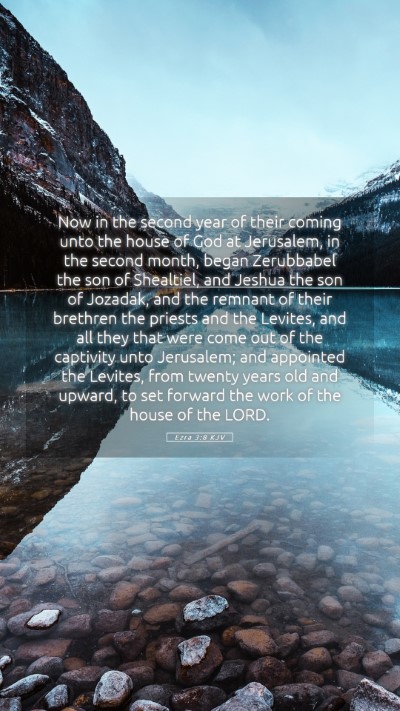Old Testament
Genesis Exodus Leviticus Numbers Deuteronomy Joshua Judges Ruth 1 Samuel 2 Samuel 1 Kings 2 Kings 1 Chronicles 2 Chronicles Ezra Nehemiah Esther Job Psalms Proverbs Ecclesiastes Song of Solomon Isaiah Jeremiah Lamentations Ezekiel Daniel Hosea Joel Amos Obadiah Jonah Micah Nahum Habakkuk Zephaniah Haggai Zechariah MalachiEzra 3:8 Meaning
What is the meaning of Ezra 3:8?
Now in the second year of their coming unto the house of God at Jerusalem, in the second month, began Zerubbabel the son of Shealtiel, and Jeshua the son of Jozadak, and the remnant of their brethren the priests and the Levites, and all they that were come out of the captivity unto Jerusalem; and appointed the Levites, from twenty years old and upward, to set forward the work of the house of the LORD.
Ezra 3:8 Bible Verse Meaning
Understanding Ezra 3:8
The verse Ezra 3:8 states: "Now in the second year of their coming unto the house of God at Jerusalem, in the second month, began Zerubbabel the son of Shealtiel, and Jeshua the son of Jozadak, and the remnant of their brethren the priests and the Levites, and all they that were come out of the captivity unto Jerusalem; and appointed the Levites, from twenty years old and upward, to set forward the work of the house of the Lord." This verse marks a significant point in the return of the Israelites from Babylonian captivity and the rebuilding of the temple.
Context and Significance
This passage occurs during a critical time in Jewish history. After 70 years in Babylon, the exiled Israelites return to Jerusalem to restore their religious practices and rebuild their temple. The leadership of Zerubbabel and Jeshua is central to this process, illustrating the importance of strong leaders in guiding the community in its spiritual revival.
Leadership and Organization
The appointment of the Levites by Zerubbabel and Jeshua signifies a methodical approach to temple restoration. Leaders took responsibility for the organization of the work. This highlights the importance of leadership in the context of God's work and reflects the idea that order and preparedness are necessary when engaging in divine tasks.
- Zerubbabel: As a governor, he symbolizes the political leadership post-exile.
- Jeshua: As the high priest, he represents the spiritual revival.
- Levites' Role: Their appointment specifies a critical position in worship and temple service.
Biblical Commentary Insights
Commentators like Matthew Henry, Albert Barnes, and Adam Clarke provide additional depth to the understanding of Ezra 3:8:
Matthew Henry's Commentary
Matthew Henry emphasizes the faithfulness of those returning from captivity and the significance of reestablishing their worship practices. He notes how the effort to rebuild the temple wasn't just a physical endeavor but a spiritual restoration as well, indicative of the community's commitment to God.
Albert Barnes' Commentary
Albert Barnes points out the importance of the timing of the reconstruction, noting it takes place in the second year after their return, showing a sense of urgency and dedication to the task at hand. He notes that the involvement of the priests and Levites highlights the communal effort and shared responsibility in this sacred venture.
Adam Clarke's Commentary
Adam Clarke provides a historical lens, explaining the Levites' role in ancient Israel's worship and their responsibilities in the temple service. He details the qualifications and age requirements for the Levites, showcasing the structured society designed to honor God through diligence and care.
Biblical Exegesis
From a perspective of biblical exegesis, this verse illustrates the themes of restoration and renewal. The collaborating leaders, Zerubbabel and Jeshua, signify a bridge between the past and the promising future after exile. Their collective action is a prepared response to God’s call for His people to return to Him, emphasizing the importance of communal faith and work.
Application in Biblical Study
This verse serves as an excellent topic for Bible study groups exploring themes of restoration, leadership, and communal responsibility in worship. Understanding the context of Ezra 3:8 enriches the reader’s understanding of how the Israelites approached their return to Jerusalem, and it can offer insights into how modern believers might approach community and collective worship.
Related Themes for Study
- The importance of spiritual leadership.
- The role of community in worship and the rebuilding of faith.
- Historical context of the post-exilic period.
Cross References
- Ezra 1:1-4: The decree allowing the Jews to return.
- Haggai 1:1-15: The call to rebuild the temple.
- Nehemiah 2:17-20: Nehemiah’s role in the rebuilding efforts.
Conclusion
Ezra 3:8 serves as a profound reminder of the importance of collective efforts in worship, effective leadership, and the community's role in the faith journey. By focusing on the elements within this verse and their interpretations, one can gain a deeper appreciation for both the historical context and the timeless truths that resonate with believers today.
This insight into Ezra 3:8 enhances the understanding of the significant role of the Israelites' return and the importance of community in worship. As such, it reminds modern-day believers of their commitment to fellowship, leadership, and service in their own faith communities.


